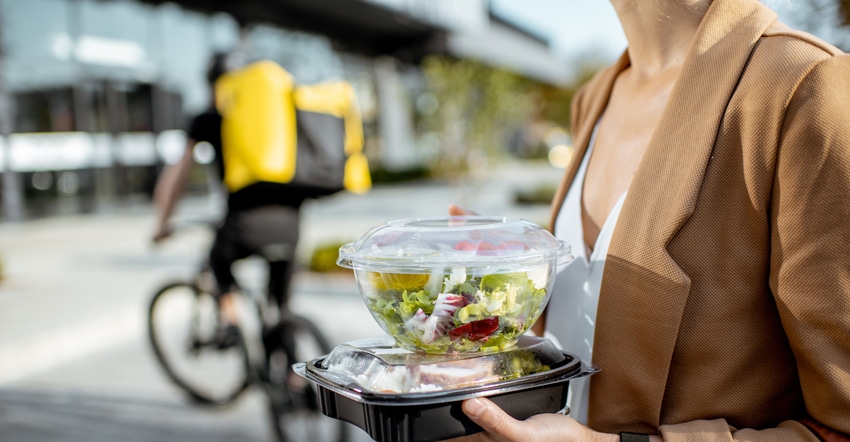Shifts caused by the pandemic in the availability, purchase, and use of packaging materials for foods and beverages for foodservice and retail linger. What materials remain popular and why?

From Lisa McTigue Pierce, Packaging Digest executive editor:
About this time last year, the world was hearing about a new SARS virus. Within weeks the threat became more apparent and closer to home, as the first cases appeared in the United States in the state of Washington.
Since then, nearly every aspect of our lives has been … disrupted by COVID-19. Over the course of the next couple months, we’ll be looking at how the packaging industry has adjusted to the new normal, which is anything but normal.
We start the series with this look at a segment of food packaging, written by Michael Carpenter:
How we got to where we are now.
In March 2020, organizations were already starting to review internal pandemic plans as the COVID-19 virus began to dominate media channels. Quickly, they realized the pandemic would have a profound effect on their operations and food packaging.
Businesses and organizations such as universities, K-12 schools, restaurants, pubs, casinos, and other dining establishments were grasping with ways to feed their customers and stay in business. Many began offering take-out and delivery as states completely shut down inside dining. Moreover, universities had students from abroad who were unable to leave campus. Organizations also had consultants and contractors from abroad on visas with immediate travel restrictions preventing return to their home countries.
A pivot towards remote working allowed businesses to continue to operate, while creating a safe environment for those unable to immediately go home. Regardless, it negatively impacted their profitability caused not only by major drop in revenue but with the added burden of large unplanned and unbudgeted purchases in packaging and personal protective equipment (PPE).
Up until mid-May 2020, the Centers for Disease Control and Prevention (CDC) advised that all non-porous containers put users at risk. Glass, tabletops, thin-wall containers, drink cups, straws all could be potential carriers of SARS-CoV-2, the virus that causes COVID-19. Numerous scientific studies are ongoing to determine the half day life of the virus on packaging materials, according to Australia’s Commonwealth Scientific and Industrial Research Organization (CSIRO).
Other studies have documented an infected person might have to cough or sneeze on the packaging. Then, while the virus was still active, someone else would have to touch that packaging before transmitting the virus to their own eyes, nose, or mouth.
However, since then, “Everything we have come to know about this virus indicates airborne person-to-person is the mode of transmission,” says Emanuel Goldman, a professor of microbiology at Rutgers University, told Time magazine.
Currently, there is no reported case or evidence that handling food packaging has resulted in contracting COVID-19. For recommendations from the CDC, visit its website.
Supply changes caused budget woes.
Packaging categories such as thin-wall containers and cutlery were in immediate demand. Most sourcing strategies were upended as organizations were unable to obtain the type of packaging they were using. Complete product families and retail plan-o-grams were impacted. In the case of a category like cutlery, food safety risk increased as cheaper alternatives were all that was available, impacting customers and the likelihood that the plastic could break off into the food.
Sustainability strategies were impacted as buyers reverted to buying expanded polystyrene (EPS) foam because it was all that was available, and it caused the least budgetary impact.
Stakeholders downstream had to deal with form, fit, and function problems. New lids often did not fit on the old cups. Material substrates like EPS, polyethylene terephthalate (PET), crystallized polyethylene terephthalate (CPET), amorphous polyethylene terephthalate (APET) and oriented polystyrene (OPS) were sourced and purchased — at times without the approval from other stakeholders on how it would affect the food or applications for which the packaging was being used. In some instances, the complete menu had to be redesigned on the fly to accommodate the type of packaging substrate that was purchased.
Packaging savings trackers based on historical purchases were suddenly at risk based on future run rates to year-end budgets. Purchases of new types of packaging, new substrates, and higher cost due to the macro supply/demand economics created additional budgetary woes.
Procurement professionals were expediting purchases to meet a surging demand, but also to secure availability as manufacturers and distributors were selling products out from under current customers and current contracts. Sales were made based on a first-come, first-serve basis and to those prepared to pay a premium to jump the queue. Many organizations did not have strategies that used global supply sources to diversify risk and to leverage global capacity. Smaller firms and establishments were typically single-sourced through one distributor. They were often forced to take what they were offered at the inflated prices.
Another impact for food packaging manufacturers was capacity. Many run production lines with overall equipment efficiency (OEE) greater than 75% to meet pricing demands and should-cost models from buyers. Manufacturers and category managers had to cut stock-keeping units (SKUs) to reduce the changeover time and costs to increase capacity.
To create more facings for core products, SKUs with at-risk volumes below sales plans were discontinued immediately to help with this surging demand. The decrease in SKUs helped manufacturers achieve OEE percentages north of 95% to help make up for other indirect expenses. However, manufacturers were left with write-offs on ancillary packaging items for the discontinued products, such as labels, printing plates, tooling, and other expenses.
What’s the effect on packaging moving forward?
The packaging market for food thermal packaging containers will see a large increase in market share from 3% or 4% to 7% or 8%. Ready-To-Eat (RTE), Ready-To-Heat (RTH), and other grab-and-go packaging concepts are likely to increase this market into double digits from 2021 to 2025. Specific raw material types such as EPS foam will continue to provide low-cost options for many applications, as long as states and municipalities do not have bans on this raw material.
The packaging market for PET — as well as other environmentally conscious products that are fiber-based, biodegradable, or recyclable — will grow as the markets move back to their new mean based on new macro trends on raw materials and category trends.
Most organizations will have allocated additional funds for PPE and packaging purchases to this year’s budget as the pandemic continues and vaccine distribution plans are put in place. Those double-digit increases are an expense that senior-level executives will try to offset through aggressive competitive bidding processes. What’s interesting for 2021 budgets is that most sustainability programs not been reduced. In fact, some are being expedited as the pandemic allows brands, retailers, and manufacturers to shift their product mix.
Many organizations do not have the internal staffing or expertise to analyze the structure and performance of an industry or cannot adjust their current packaging spend, global sourcing and sustainability goals based internal organizational behavior. Instead, they are turning to outside experts for strategies to develop domestic and international solutions that diversity their risks, program management, and operational support.
About the Author(s)
You May Also Like




